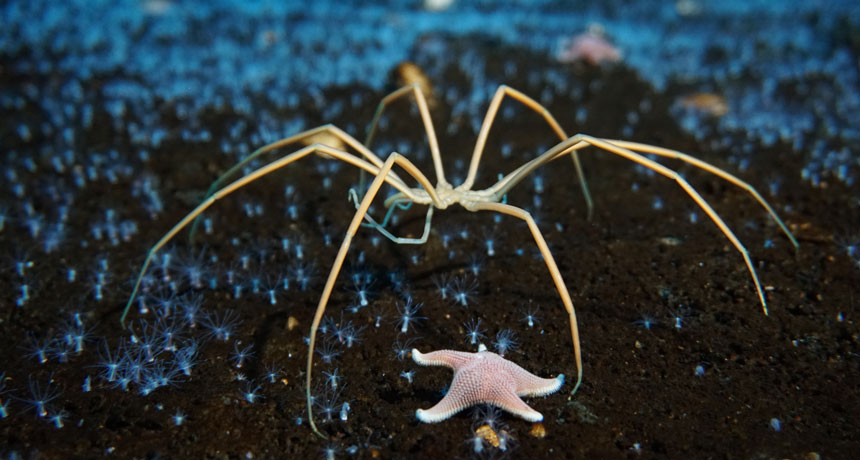
LEGGY MULTITASKERS The skinny legs of sea spiders (one shown from Antarctica) hold guts that digest food and help pump blood.
Timothy Dwyer (PolarTREC 2016), Courtesy of ARCUS
NEW ORLEANS — A newfound way of delivering oxygen in animal circulatory systems depends mostly on food sloshing back and forth in the guts.
This discovery came in sea spiders, or pycnogonids, which can look like legs in search of a body. Their spookily long legs hold stretches of digestive tract, which wouldn’t fit inside the creatures’ scrap of an abdomen. Waves of contraction sweeping up and down the leggy guts cause blood outside the guts to move too, evolutionary physiologist Art Woods of the University of Montana in Missoula said January 8 at the annual meeting of the Society for Integrative and Comparative Biology. As lumpy surges of partly digested food rise and fall, blood that has picked up oxygen by diffusion whooshes to the rest of the body, Woods proposed.
“Essentially they use their legs like gills,” says Jon Harrison, an evolutionary physiologist at Arizona State University in Tempe, who was not involved in the research. “To my knowledge, no one had thought of this before — certainly no one has demonstrated this before.”
The roughly 1,300 sea spider species aren’t true spiders but a closely related lineage of arthropods. They feed via a long proboscis that doesn’t punch into food but gnaws at it bit by bit and then sucks up the smaller nuggets. Those nuggets typically come from hunting or scavenging other invertebrates. Jellyfish and hydroids are some sea spiders’ favorites with occasional other snacks such as clams or sea slugs. Various sea spider species live from the tropics to the poles, and in Antarctica, sea spiders grow to a leg span wider than a dinner plate.
Woods and colleagues were studying this polar gigantism when they began thinking through the spiders’ oxygen consumption. A sea spider’s outer covering is porous enough for oxygen to diffuse through. But the researchers calculated that mere diffusion without some kind of inner pump couldn’t meet these animals’ oxygen needs.
Most sea spider species have a heart and, like other arthropods, an open circulatory system. The heart shoots a pulse of blood out open-ended vessels where it washes over body tissues and then flows back into the heart’s uptake plumbing.
A sea spider heart might boost flow to such blood-hungry zones as the muscular proboscis, but the researchers didn’t see big, regular pulses of blood radiating outward through the body. Hearts probably aren’t the whole story for circulation, Woods concluded.
The researchers also observed that there’s more oxygen in the tips of the legs. Gut activity could then drive the newly oxygenated blood up the leg toward the rest of the body. A video showed a stretch of gut bulging wide inside the leg as a dollop of food washed through, shrinking as the wake died away and then swelling again as a food wave arrived from the opposite direction. These motions inside gut tissue let the oxygen-enriched blood circulate, Woods proposed.
To test the idea, the researchers lowered the oxygen content of water around sea spiders. The movements of the digestive tract increased, as expected if the guts had to work harder to supply oxygen. And when researchers raised the water temperature for both polar and temperate species, which revs up metabolism and increases oxygen demand, gut activity increased, too.
Woods proposes that sea spider blood circulation by gut motion might prove to be what paleontologist Stephen Jay Gould called an exaptation, a trait with one function that over the course of evolution takes on another. Woods’ guess: The digestive system formed first and later happened into circulation.






